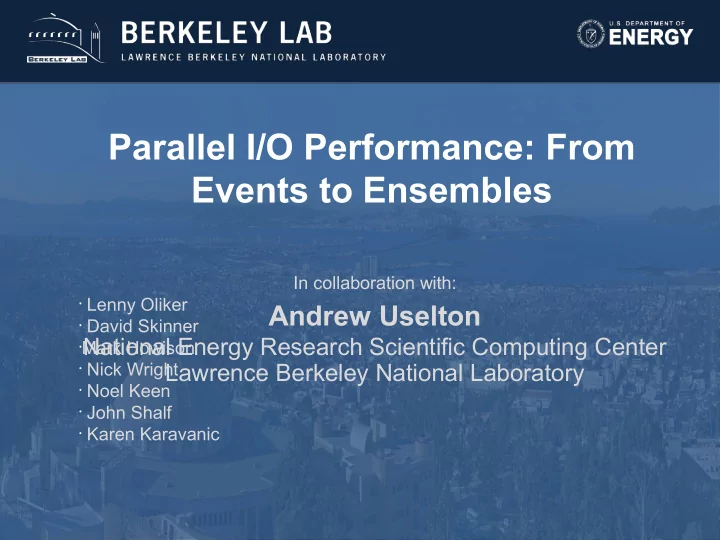

Parallel I/O Performance: From Events to Ensembles In collaboration with: • Lenny Oliker Andrew Uselton • David Skinner National Energy Research Scientific Computing Center • Mark Howison • Nick Wright Lawrence Berkeley National Laboratory • Noel Keen • John Shalf • Karen Karavanic
Parallel I/O Evaluation and Analysis • Explosion of sensor & simulation data make I/O a critical component • Petascale I/O requires new techniques: analysis, visualization, diagnosis • Statistical methods can be revealing • Present case studies and optimization results for: • MADbench – A cosmology application • GCRM – A climate simulation 2
IPM-I/O is an interposition library that wraps I/O calls with tracing instructions Job trace input IPM-I/O Read I/O Barrier Write I/O job trace output 3
Events to Ensembles The details of a trace can obscure as much as they reveal And it does not scale Statistical methods reveal what the trace obscures And it does scale Task 0 count Task 10,000 Wall clock time
Case Study #1: MADCAP analyzes the Cosmic Microwave Background radiation. Madbench – An out-of-core matrix solver writes and reads all of memory multiple times.
CMB Data Analysis time domain - O (1012) pixel sky map - O (108) angular power spectrum - O (104)
MADbench Overview u MADCAP is the maximum likelihood CMB angular power spectrum estimation code u MADbench is a lightweight version of MADCAP u Out-of-core calculation due to large size and number of pix-pix matrices
Computational Structure I. Compute, Write III. Read, Compute, IV. Read, (Loop) Write (Loop) Compute/Communic ate (Loop) task The compute intensity wall clock time can be tuned down to II. Compute/Communicate emphasize I/O (no I/O)
MADbench I/O Optimization Phase II. Read # 4 5 6 7 8 Click to edit Master text styles Second level ● Third level ● Fourth level ● Fifth level task wall clock time
MADbench I/O Optimization count duration (seconds)
MADbench I/O Optimization Cumulative Probability A statistical approach revealed a systematic duration (seconds) pattern
MADbench I/O Optimization Click to edit Master text styles Second level Process# ● Third level Before ● Fourth level ● Fifth level Time After Lustre patch eliminated slow reads
Case Study #2: Global Cloud Resolving Model (GCRM) developed by scientists at CSU Runs resolutions fine enough to simulate cloud formulation and dynamics Mark Howison’s analysis fixed it
GCRM I/O Optimization Task 0 Click to edit Master text styles Second level At 4km ● Third level resolution ● Fourth level ● Fifth level GCRM is dealing with a lot of data. The goal is to work at 1km and 40k tasks, which Task will require 16x as much 10,000 data. Wall clock time desired checkpoint time
GCRM I/O Optimization Worst case 20 sec Insight: all 10,000 are happening at once
GCRM I/O Optimization Worst case 3 sec Collective buffering reduces concurrency
GCRM I/O Optimization Click to edit Master text styles Second level ● Third level ● Fourth level Before ● Fifth level desired checkpoint time After
GCRM I/O Optimization Insight: Still need Aligned better I/O worst case behavior Worst case 1 sec
GCRM I/O Optimization Before desired checkpoint time After
GCRM I/O Optimization Sometimes the trace view is the right way to look at it Metadata is being serialized through task 0
GCRM I/O Optimization Defer metadata ops so there are fewer and they are larger
GCRM I/O Optimization Before desired checkpoint time After
Conclusions and Future Work Traces do not scale, can obscure underlying features Statistical methods scale, give useful diagnostic insights into large datasets Future work: gather statistical info directly in IPM Future work: Automatic recognition of model and moments within IPM
Acknowledgements • Julian Borrill wrote MADCAP/MADbench • Mark Howison performed the GCRM optimizations • Noel Keen wrote the I/O extensions for IPM • Kitrick Sheets (Cray) and Tom Wang (SUN/Oracle) assisted with the diagnosis of the Lustre bug • This work was funded in part by the DOE Office of Advanced Scientific Computing Research (ASCR) under contract number DE-C02-05CH11231
Recommend
More recommend